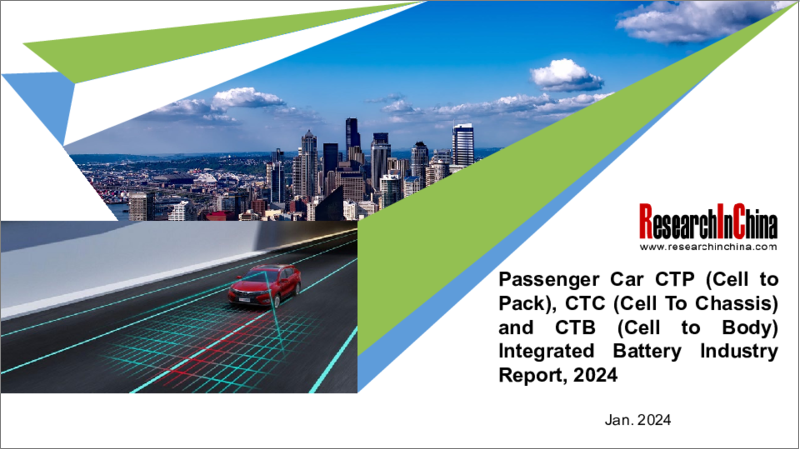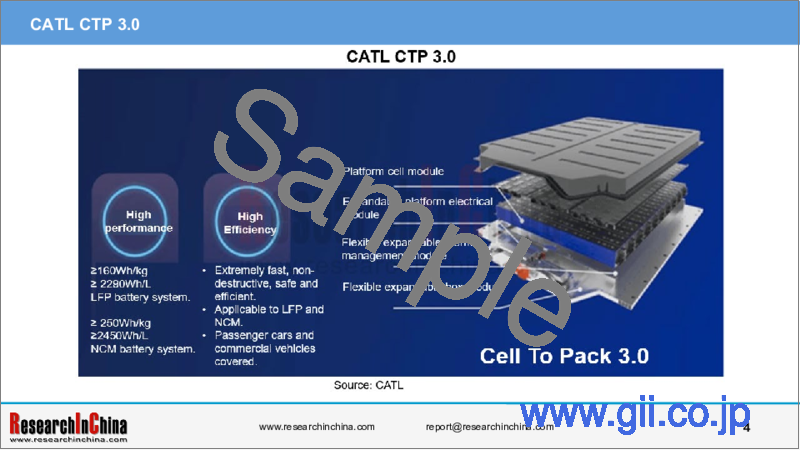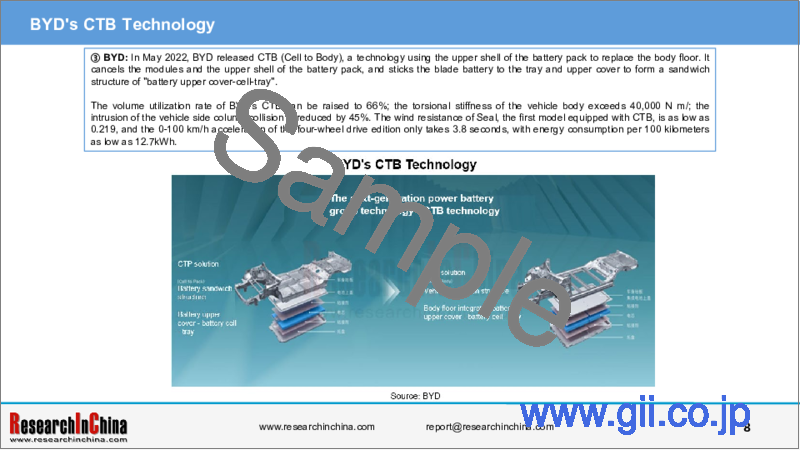|
|
市場調査レポート
商品コード
1420126
乗用車用CTP/CTC/CTB統合バッテリー産業(2024年)Passenger Car CTP (Cell to Pack), CTC (Cell To Chassis) and CTB (Cell to Body) Integrated Battery Industry Report, 2024 |
||||||
|
|||||||
| 乗用車用CTP/CTC/CTB統合バッテリー産業(2024年) |
|
出版日: 2024年01月04日
発行: ResearchInChina
ページ情報: 英文 205 Pages
納期: 即日から翌営業日
|
- 全表示
- 概要
- 目次
2023年、販売された新エネルギー車の50%近くでCTP技術が見られました。
2021年、中国でCTPを搭載した車両モデルは13しかありませんでした。2023年10月時点では57車両タイプに増加しています。2021年の新エネルギー車(EV、PHEV、EREV)の販売に占めるCTP搭載車の比率は29.6%で、2023年1~10月は48.6%、2023年通年では50%を超えると予測されます。
サプライヤーとOEMの双方から見て、CTP技術は成熟した応用段階に入っています。
サプライヤーの中では、CATLがロールモデルとなっています。2019年、CATLはCTP 1.0をリリースしました。2023年、この技術は3.0まで反復し、ZEEKR、Li Auto、AITOなどのブランドで設置されています。
OEMの代表はBYDです。2020年、BYDはCTP技術に基づくブレードバッテリーを発表し、同年6月にHan EVに初搭載しました。2023年、ブレードバッテリーの大容量化に伴い、BYDは自社の需要を満たした後、その他の自動車メーカーにバッテリーを供給し始めました。TeslaとHongqiは、ブレードバッテリーを搭載したモデルをいくつか保有しています。
ResearchInChinaの統計によると、ブレードバッテリーを採用したモデルは17以上あります。2023年末までに、BYDは17のブレードバッテリー生産拠点を展開し、460GWh超の容量を計画しています。
当レポートでは、中国の乗用車用CTP/CTC/CTB統合バッテリー産業について調査分析し、産業の現状や、関連製品のOEMとサプライヤーのレイアウト、将来の発展動向などの情報を提供しています。
目次
第1章 乗用車用CTP/CTC/CTB産業の概要
- 乗用車用統合バッテリーの開発背景と歴史
- 乗用車用統合バッテリーの定義と産業発展の背景
- 乗用車用統合バッテリーの進化
- 統合バッテリー:CTP技術
- CTPの定義
- CTPテクノロジールート
- 従来のバッテリーパックと比較したCTPの利点
- CTPの欠点とその影響
- CTP産業の現状
- 統合バッテリー:CTC技術
- CTCの定義
- CTCテクノロジールート
- CTCの技術的問題と統合ソリューション
- CTCとCTPの比較
- CTCの利点と欠点
- CTC産業の現状と利用例
- CTCの影響
- 統合バッテリー:CTB技術
- CTBの定義
- CTBとCTPの比較
- CTBとCTCの比較
- CTBの利点と欠点
- 部品点数とグループ効率に対するバッテリーパック統合の影響
- CTP/CTC/CTB技術の比較
- 中国のバッテリー統合政策
- バッテリー統合技術の開発における中国バッテリーベンダーの優位性
- 統合バッテリーサプライヤーの製品レイアウト
- 統合バッテリーOEMの製品レイアウト
第2章 乗用車用バッテリー統合のTier 1サプライヤー
- CATL
- CNP
- Tianjin EV Energies (JEVE)
- SVOLT Energy
- CALB
- AESC
- LG Energy Solution
- SK On
- Farasis Energy
- EVE
- SEVB
- REPT
- FinDreams Battery
- BAK Batteryとキャパシティプランニング
- Lishen BatteryのCTPとCTC技術計画
- Greater Bay TechnologyのPhoenix Battery
第3章 乗用車OEMの統合バッテリーレイアウト
- Leapmotor
- BYD
- Tesla
- BAIC BJEV
- SAIC
- Neta Automobile
- Volvo
- Volkswagen
- JACのCTCテクニカルソリューション
- HYCANのCTP技術
- FordのCTP技術
- Changan Automobileのバッテリー技術とキャパシティレイアウト
- Great Wall MotorのCTC技術
- FAWのCTP技術
- GACのCTP超急速充電バッテリーシステム
- NIOのCTP技術
- XpengのCIB技術とサポートされるモデル
- Cheryの統合バッテリー技術とキャパシティレイアウト
- ZEEKRのCTP技術
- Xiaomi AutomobileのCTB技術
第4章 乗用車用統合バッテリー産業の発展動向
Passenger Car CTP, CTC and CTB Integrated Battery Industry Report, 2024 released by ResearchInChina summarizes and studies the status quo of CTP (Cell to Pack), CTC (Cell To Chassis) and CTB (Cell to Body) for passenger cars and the layout of OEMs and suppliers in related products, and predicts the future development trends of passenger car integrated batteries.
1. In 2023, CTP (Cell to Pack) technology was seen in nearly 50% of new energy vehicles sold.
In 2021, there were only 13 vehicle models equipped with CTP in China. As of October 2023, the number had increased to 57. Vehicles equipped with CTP shared 29.6% of the total sales of new energy vehicles (EVs, PHEVs and EREVs) in 2021, and made up 48.6% from January to October 2023, a figure projected to be higher than 50% in the whole year of 2023.
From the perspective of both suppliers and OEMs, CTP technology has entered a mature application stage.
Among suppliers, CATL is a role model. In 2019, CATL released its CTP 1.0. By 2023, the technology has iterated to 3.0, and has been installed by brands such as ZEEKR, Li Auto and AITO.
OEMs are represented by BYD. In 2020, BYD released its blade battery based on CTP technology, which was first mounted on Han EV in June of the same year. In 2023, with higher blade battery capacity, BYD began to supply batteries to other automakers after meeting its own demand. Both Tesla and Hongqi have some models equipped with the blade battery.
According to the statistics of ResearchInChina, there are more than 17 models using blade batteries. By the end of 2023, BYD had deployed 17 blade battery production bases with the planned capacity of over 460GWh.
2. CTC/CTB technology is easier to implement under the leadership of OEMs
2.1 Currently only four automakers Tesla, BYD, Leapmotor and Xpeng have released CTC/CTB technology and applied it in production models.
- 1. Tesla: In 2020, Tesla introduced the concept of CTC (Cell To Chassis) for the first time on its Battery Day, which cancels the floor of the vehicle body, integrates the battery frame with the underbody (rocker rail, transverse beam, longitudinal beam, floor, etc.), and then connects the castings at the front and rear ends of the body.
From the point of performance improvement, Tesla's CTC technology offers the benefits: a 10% reduction in vehicle weight, a 14% increase in cursing range, a reduction of 370 parts, 7% lower unit cost, 8% lower unit investment, and far higher automobile manufacturing efficiency. CTC technology has been applied to Model Y produced at Gigafactory Texas.
- 2. Leapmotor: In April 2022 Leapmotor released CTC technology, and first applied it to the production model Leapmotor C01. Leapmotor's CTC solution cancels the battery pack housing and upper cover, and retains the integrated battery module and lower battery tray.
Leapmotor's CTC technology can increase the vertical space of the vehicle by 10mm, the battery layout space by 14.5%, the cursing range by 10% and the torsional stiffness of the body by 25% to 33897N*m/°, and reduce the number of parts by 20% and the weight by 15kg. CTC 2.0 unveiled by Leapmotor in 2023 enables 10% fewer parts and 5% less weight than CTC 1.0.
- 3. BYD: In May 2022, BYD released CTB (Cell to Body), a technology using the upper shell of the battery pack to replace the body floor. It cancels the modules and the upper shell of the battery pack, and sticks the blade battery to the tray and upper cover to form a sandwich structure of "battery upper cover-cell-tray".
The volume utilization rate of BYD's CTB can be raised to 66%; the torsional stiffness of the vehicle body exceeds 40,000 N m/; the intrusion of the vehicle side column collision is reduced by 45%. The wind resistance of Seal, the first model equipped with CTB, is as low as 0.219, and the 0-100 km/h acceleration of the four-wheel drive edition only takes 3.8 seconds, with energy consumption per 100 kilometers as low as 12.7kWh.
- 4. Xpeng: In April 2023, Xpeng launched its "Fuyao" architecture, which adopts CIB technology that uses the upper cover of the battery pack as the body floor, thereby saving 5% vertical interior space. As with Tesla, Xpeng integrates the reserved mounting bracket on the battery pack upper cover, and installs seats directly on the battery pack.
2.2 As per the technical features of CTC/CTB, OEMs cannot tolerate less say.
In the conventional new energy industry chain, power batteries account for 30%~40% of the vehicle cost. In the promotion process of CTC technology, the use of CTC makes it easier for battery vendors to dabble in chassis and vehicle development. For automakers, this may lead to less say, which is unacceptable to them.
CTC technology however requires battery cells with high intrinsic safety, and this needs to enhance thermal stability of battery cell materials. As concerns process, it is necessary to ensure the reliability of battery cells in terms of design and manufacturing. These are the advantages of battery vendors. Amid a combination of multiple factors, the model that OEMs play a leading role and suppliers cooperate with them may be the main way to advance CTC technology in the future.
In the case above OEMs that have the ability to develop and produce battery cells by themselves, such as BYD and Tesla, can effectively avoid the technical restrictions from battery vendors and have greater advantages in technology application.
2.3 CTC technology layout of other OEMs
In addition to Tesla, BYD, Leapmotor and Xpeng, Xiaomi, Volkswagen, Volvo, JAC and SAIC all make layout of CTC technology. On December 28, 2023, Xiaomi unveiled SU7, a car that packs its self-developed CTB technology. The innovative designs such as floor-cover two-in-one, battery cell inversion, multifunctional elastic interlayer and minimalist wiring harness enable the volume efficiency up to 77.8% and release an additional height of 17 mm.
Table of Contents
1. Overview of Passenger Car CTP, CTC and CTB Industry
- 1.1. Development Background and History of Integrated Batteries for Passenger Cars
- 1.1.1. Definition of Integrated Batteries for Passenger Cars and Industrial Development Background
- 1.1.2. Evolution of Integrated Batteries for Passenger Cars
- 1.2. Integrated Batteries: CTP Technology
- 1.2.1. Definition of CTP
- 1.2.2. CTP Technology Route
- 1.2.3. Advantages of CTP Compared with Conventional Battery Packs
- 1.2.4. Disadvantages of CTP and Impacts
- 1.2.5. Status Quo of CTP Industry
- 1.3. Integrated Batteries: CTC Technology
- 1.3.1. Definition of CTC
- 1.3.2. CTC Technology Route
- 1.3.3. CTC Technical Difficulties and Integration Solutions
- 1.3.4. Comparison between CTC and CTP
- 1.3.5. Advantages and Disadvantages of CTC
- 1.3.6. Status Quo of CTC Industry and Application Cases
- 1.3.7. Impact of CTC
- 1.4. Integrated Batteries: CTB Technology
- 1.4.1. Definition of CTB
- 1.4.2. Comparison between CTB and CTP
- 1.4.3. Comparison between CTB and CTC
- 1.4.4. Advantages and Disadvantages of CTB
- 1.5. Impact of Battery Pack Integration on the Number of Parts and Group Efficiency
- 1.6. Comparison among CTP, CTC and CTB Technologies
- 1.7. China's Battery Integration Policies
- 1.8. Advantages of Chinese Battery Vendors in Developing Battery Integration Technology
- 1.9. Product Layout of Integrated Battery Suppliers
- 1.10. Product Layout of Integrated Battery OEMs
2. Tier1 Suppliers of Passenger Car Battery Integration
- 2.1. CATL
- 2.1.1. Global Layout
- 2.1.2. Power Battery Industry Chain Layout
- 2.1.3. Power Battery System Integration Technology Roadmap
- 2.1.4. Development History of CTP Technology
- 2.1.5. CTP 2.0: Technical Features
- 2.1.6. CTP 3.0: Kirin Batteries
- 2.1.7. CTP 3.0: Shenxing Batteries
- 2.1.8. CTC Technology Layout
- 2.1.9. Models Supported
- 2.1.10. Cooperation
- 2.1.11. Global Market Share
- 2.1.12. Capacity Planning and Overseas Layout
- 2.2. CNP
- 2.2.1. Product Layout
- 2.2.2. Features of Electric CTC
- 2.2.3. Cooperation and Layout in Electric CTC
- 2.3. Tianjin EV Energies (JEVE)
- 2.3.1. Product Layout
- 2.3.2. CTP Batteries
- 2.3.3. CTP Structure System
- 2.3.4. Strategic Cooperation
- 2.4. SVOLT Energy
- 2.4.1. Global Prodcution and R&D Layout
- 2.4.2. Product Layout
- 2.4.3. Development History of Power Batteries
- 2.4.4. Core Technology
- 2.4.5. Cobalt-free Battery LCTP Technology
- 2.4.6. Short Blade Battery LCTP Technology
- 2.4.7. LCTP 3.0
- 2.4.8. L400 Short Blade Batteries
- 2.4.9. Ultra-high-speed Lamination Technology 3.0
- 2.4.10. Projects under Development
- 2.4.11. Investment
- 2.4.12. Models Supported
- 2.4.13. Capacity Planning
- 2.5. CALB
- 2.5.1. Product Layout
- 2.5.2. Square CTP Battery Packs for Mass Production
- 2.5.3. One-Stop Products
- 2.5.4. 4C and 6C Fast Charging Products
- 2.5.5. Models Supported
- 2.5.6. Capacity Planning
- 2.6. AESC
- 2.6.1. Global Layout
- 2.6.2. Product Layout and Future Planning
- 2.6.3. Technology and Products
- 2.6.4. Customers
- 2.7. LG Energy Solution
- 2.7.1. Global Layout
- 2.7.2. Product Layout
- 2.7.3. Battery Cells
- 2.7.4. Modules
- 2.7.5. Battery Business Development Strategy
- 2.7.6. Capacity Layout (2023)
- 2.7.6. Capacity Layout (2025)
- 2.7.6. Capacity Layout (North America)
- 2.7.7. Technology Solutions
- 2.7.8. CTP Technology
- 2.7.9. CTC Technology
- 2.7.10. Customers
- 2.7.11. Future Technology Route
- 2.8. SK On
- 2.8.1. CTP Manufacturing Process
- 2.8.2. EV-CTP Technology
- 2.8.3. Fast Charging Battery Technology
- 2.8.4. Core Technology
- 2.8.5. Customers
- 2.8.6. Capacity Layout and Planning
- 2.8.7. Next-generation Battery Planning
- 2.9. Farasis Energy
- 2.9.1. Global Layout
- 2.9.2. SPS Technology of Power Battery Solutions
- 2.9.3. Technical Advantages of SPS
- 2.9.4. SPS Battery Patents
- 2.9.5. SPS Capacity and Designation
- 2.10. EVE
- 2.10.1. Power Battery Layout
- 2.10.2. "pi" Battery System
- 2.10.3. 46 Large Cylindrical Battery Packs
- 2.10.4. Capacity Planning
- 2.11. SEVB
- 2.11.1. Global and Product Layout
- 2.11.2. Features of Flash Charging Batteries
- 2.11.3. Square Charging Product Solutions
- 2.11.4. Performance Indexes of Square Flash Charging Batteries
- 2.11.5. Square Flash Charging Battery Planning
- 2.11.6. Cylindrical Flash Charging Battery Solutions
- 2.11.7. Capacity Planning
- 2.12. REPT
- 2.12.1. Global Industrial Layout and Capacity Planning
- 2.12.2. "Wending" Power Battery
- 2.12.3. Technical Features Advantages of "Wending"
- 2.12.4. CTP Pack
- 2.12.5. Power Battery Layout and Mass Production Planning
- 2.12.6. Customers
- 2.13. FinDreams Battery
- 2.13.1. Industry and Industrial Chain Layout
- 2.13.2. Pack Capability
- 2.13.3. Structural Advantages of CTB
- 2.13.4. Capacity Planning
- 2.14. BAK Battery and Capacity Planning
- 2.15. CTP and CTC Technical Planning of Lishen Battery
- 2.16. Phoenix Battery of Greater Bay Technology
3. Integrated Battery Layout of Passenger Car OEMs
- 3.1. Leapmotor
- 3.1.1. Battery Technology Iteration
- 3.1.2. CTC 1.0
- 3.1.3. Advantages of CTC 1.0
- 3.1.4. CTC 2.0
- 3.1.5. Models Supported by CTC 1.0& 2.0
- 3.2. BYD
- 3.2.1. Development History of Battery Technology
- 3.2.2. CTP Technical Products: Blade Batteries
- 3.2.3. CTB Technology
- 3.2.4. Technical Features of CTB
- 3.2.5. Technical Advantages of CTB
- 3.2.6. Models Supported by CTB Technology
- 3.2.7. CTC Technology
- 3.2.8. Subsidiaries: Findreams Battery
- 3.2.9. Capacity Planning
- 3.3. Tesla
- 3.3.1. Battery Technology Roadmap
- 3.3.2. CTC Technology
- 3.3.3. Advantages and Disadvantages of CTC Technology
- 3.3.4. Features of 4680 Battery
- 3.3.5. Innovation of 4680 Battery
- 3.3.6. Models Supported
- 3.4. BAIC BJEV
- 3.4.1. CTP Cooperation and Models Supported
- 3.4.2. R&D Project Layout
- 3.5. SAIC
- 3.5.1. BMFA Battery
- 3.5.2. Features of BMFA Battery
- 3.5.3. Advantages of BMFA Battery
- 3.5.4. SAIC Nebula Battery-electric Systematic Platform
- 3.5.5. Models Supported by CTP Technology
- 3.5.6. CTC Technology Layout
- 3.6. Neta Automobile
- 3.6.1. Tiangong Battery System Development Route
- 3.6.2. Tiangong Battery 2.0
- 3.6.3. Models Supported by Tiangong Battery 2.0
- 3.6.4. Haozhi Skateboard Chassis Platform
- 3.6.5. Cooperation in CTP/CTC Technology
- 3.7. Volvo
- 3.7.1. Battery Integration Technology
- 3.7.2. Application of CTC Technology
- 3.7.3. Capacity and Cooperation Planning
- 3.8. Volkswagen
- 3.8.1. Battery Technology Layout
- 3.8.2. CTC Technology
- 3.8.3. Capacity Planning
- 3.9. CTC Technical Solutions of JAC
- 3.10. CTP Technology of HYCAN
- 3.11. CTP Technology of Ford
- 3.12. Battery Technology and Capacity Layout of Changan Automobile
- 3.13. CTC Technology of Great Wall Motor
- 3.14. CTP Technology of FAW
- 3.15. CTP Super Fast Charging Battery System of GAC
- 3.16. CTP Technology of NIO
- 3.17. Xpeng's CIB Technology and Models Supported
- 3.18. Chery's Integrated Battery Technology and Capacity Layout
- 3.19. ZEEKR's CTP Technology
- 3.20. CTB Technology of Xiaomi Automobile
4. Development Trends of Passenger Car Integrated Battery Industry
- 4.1. Trend 1
- 4.2. Trend 2
- 4.3. Trend 3
- 4.4. Trend 4
- 4.5. Trend 5






